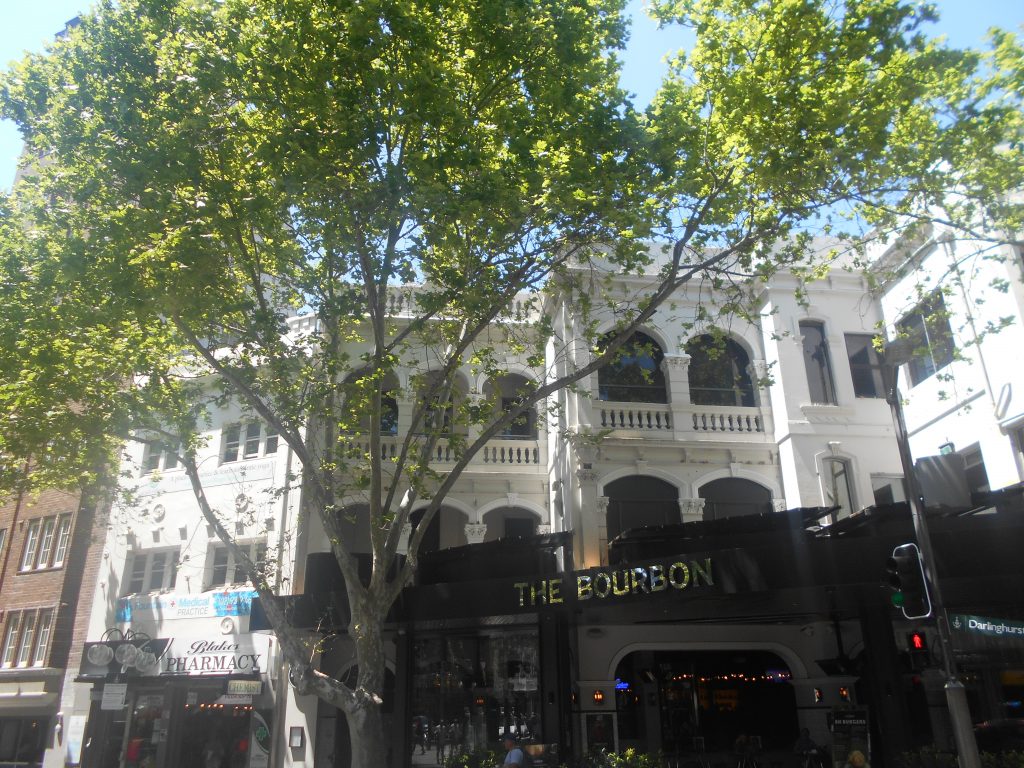THE BOURBON

The Bourbon Bar is synonymous with Kings Cross. And it has had more lives than a cat.
In the 1850s the grounds of substantial villas in the area were sub-divided and terraces and mansions erected.
In 1889 the Roslyn Estate, where St Luke’s Hospital now is, was subdivided and sold including lots facing Darlinghurst Road. Sales were slow.
Around 1904 number 24 Darlinghurst Road, the Bourbon site, was built as a substantial pair of houses in the ornate but old-fashioned “Melbourne” style with ornate Italianate white arches etc. The owner was William Bakewell, a wealthy brick, tile and pottery works owner.
Bakewell died in 1907 but by 1904 it had become the Charlemount Private Hospital. Operating rooms were established in 1909. The hospital existed until 1919 and the site was converted to a boarding house/hotel, whose appeal was aided by new trams and increasing motor vehicles assisting access to and from the suburbs.
Later, in 1922, the site became a hospital again until 1929, and by 1934 had moved further along and into Macleay Street.
In 1929 Kings Cross was known for its menacing bohemian character and more “continental flavour”. The Cross was the most densely populated area in Sydney.
During World War II (1939-1945) the area was popular with US defence personnel at nearby Garden Island on leave.
And during the Vietnam War (1955-1975) it was equally as rowdy and rambunctious and popular.
Bernie Houghton (1920-2000) whose real name was Maurice Bernard Houghton, settled in Sydney in 1967. He was a larger-than life colourful Texan. He had served in the US military in World War II, spending three years in Southeast Asia. After the Vietnam War he traded in opium and slot machines. He was identified by the Australian task force examining the Nugan Hand Bank collapse to be “part of the American intelligence community”. Houghton and his staff collected at least $5 million in cash from US expatriates, all of which disappeared with the bank’s collapse in 1980.
He helped arrange arms deals, supplying weapons to groups in southern Africa, and had links to corrupt former NSW Premier, Robert Askin, the Kings Cross underbelly impresario, Abe Saffron, John Walker, the CIA’s Australian Station Chief from 1973-75, Robert Wilson (US Naval Intelligence), and the Head of ASIO who personally vouched for him when he arrived in Australia without a visa: claims he was a CIA spy were never proved.
He founded several bars in Kings Cross including the highly successful Bourbon and Beefsteak, which opened in October 1967. It took advantage of US servicemen taking rest and recreation from the Vietnam War, a trade worth $9 million a month to the area.
Houghton left Australia in mid-1980, returning in October 1981 when it appeared that the investigations into the collapsed bank were unlikely to legally endanger him.
After Houghton’s death in 2000, a life-size bust sculpture and plaque were proposed for the foyer of the Bourbon. The memorial was the work of local sculptor, Tony Johansen. The move, partly in recognition of Houghton’s $1.5m worth of charitable donations, was approved by the former South Sydney Council. After a heated council debate it was decided to erect it in a more prominent public position in heritage-listed Fitzroy Gardens. It was unveiled in July 2002 on the northern edge of the park facing south but was moved after recent re-landscaping works about three metres west.
The Bourbon’s white arches, from which they still serve over a dozen types of Bourbon whisky, are a prominent landmark in the street.
By Andrew Woodhouse, Heritage Solutions





